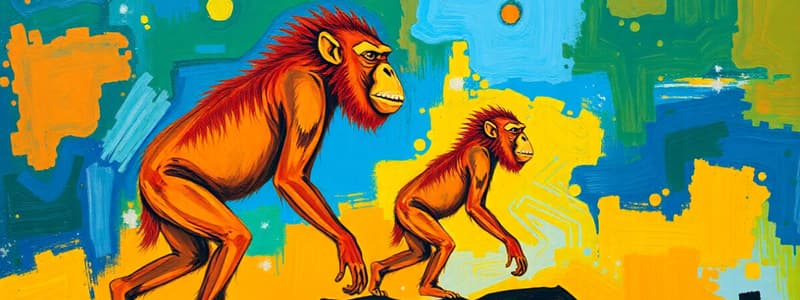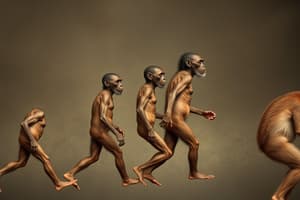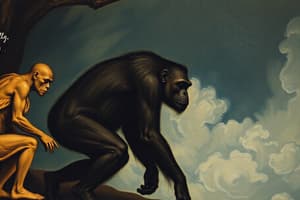Podcast
Questions and Answers
Which characteristic is unique to humans compared to other hominoids?
Which characteristic is unique to humans compared to other hominoids?
- Bipedal locomotion as the primary means of movement. (correct)
- Grasping hands used for manipulating objects.
- Forward-looking eyes providing depth perception.
- Complex social behaviours within groups.
If a new species is discovered that exhibits both grasping hands and forward-facing eyes, how would it be classified?
If a new species is discovered that exhibits both grasping hands and forward-facing eyes, how would it be classified?
- Primate (correct)
- Australopithecus
- Hominin
- Hominoid
What is the most accurate classification for chimpanzees and bonobos, based on their relationship to humans?
What is the most accurate classification for chimpanzees and bonobos, based on their relationship to humans?
- They are hominoids and the closest living relatives to humans. (correct)
- They are a type of hominin, sharing a recent common ancestor with humans.
- They are a distinct group of mammals, unrelated to primates.
- They are primates, closely related to monkeys and prosimians.
Which of the following best describes the evolutionary relationship between primates, hominoids, and hominins?
Which of the following best describes the evolutionary relationship between primates, hominoids, and hominins?
An archeologist discovers a fossil with human-like hands and evidence of bipedalism, dating back 3.5 million years. This fossil likely belongs to which group?
An archeologist discovers a fossil with human-like hands and evidence of bipedalism, dating back 3.5 million years. This fossil likely belongs to which group?
Flashcards
Evolution
Evolution
Change in genotypic frequencies in a population over generations.
Primates
Primates
Order of mammals characterized by grasping hands, forward-looking eyes and complex social behavior.
Hominoids
Hominoids
A subcategory of primates including humans, gorillas, orangutans, chimpanzees, and gibbons.
Hominins
Hominins
Signup and view all the flashcards
Australopithecus
Australopithecus
Signup and view all the flashcards
Study Notes
- Evolution is defined as the change in the genotypic frequencies in a population across generations.
Primates
- Humans are classified as primates, characterized by fingerprints, complex social behaviors, grasping hands, and forward-looking eyes.
Hominoids
- Within primates, humans belong to the great apes, a subcategory of hominoids.
- Hominoids include humans, gorillas, orangutans, chimpanzees, and gibbons.
- All hominoids are primates, but not all primates are hominoids.
- Humans differ from other hominoids by walking on two feet (bipedalism).
- Chimpanzees and bonobos are humans' closest living relatives.
Evolution from Primates to Hominins
- Primates existed approximately 50 million years ago, encompassing prosimians, monkeys, apes, and humans.
- Key primate features include grasping hands/feet and forward eye orientation, aiding in clinging, branch hanging, and food capture.
- Early primates diverged into Old World primates (Africa and Asia) and New World primates (South America).
- Distinguishing human characteristics include large brains, bipedal locomotion, language, and complex tool use.
- Humans uniquely alter their environment and inhabit diverse climates.
- Hominoids evolved in Africa, appearing 5-7 million years ago.
- Hominins, a subtype of hominoid, include modern humans, extinct species, and human ancestors.
Australopithecus
- Known as the "southern ape," Australopithecus was a bipedal hominid with human-like hands but a smaller brain.
- They existed from 3.8 to 2.9 million years ago.
- Lucy, discovered in Ethiopia in 1974, is an example of Australopithecus, living over 3 million years ago.
- Fossil studies indicate Lucy was about 3 feet tall and walked upright on two legs.
Homo Habilis
- Homo habilis is the first known member of the Homo genus, living 1.6-2.4 million years ago.
- As a recent human ancestor in the Homo genus, indicating a closer genetic link.
- Fossils place them in Africa, existing simultaneously with Homo erectus.
- They lived for roughly 500,000 years before extinction.
- Tool use is evidenced by tools found among Homo habilis bones near Lucy's discovery site.
Homo Erectus
- Homo erectus was the first hominin to migrate out of Africa.
- They stood erect, unlike other hominins, and had longer legs than arms.
- The first Homo erectus fossil, Java Man, was found in Java in 1891.
- Compared to Homo habilis, Homo erectus was larger with a bigger brain.
- They lived in groups, hunted large animals and potentially used and made fire.
- The species crafted tools from stone and bone
- Homo erectus spread to Asia and Europe, living for about 1 million years.
- They went extinct approximately 200,000 years ago, before modern humans.
Neanderthals (Homo Neanderthalensis)
- Neanderthals were human-like hominins inhabiting Eurasia alongside humans until extinction.
- Despite resemblance, they are genetically distinct.
- They had powerful builds and distinct skull features like large size, protruding faces, and bony brow ridges.
- Interbreeding between some humans and Neanderthals resulted in Neanderthal genes in humans, particularly in non-sub-Saharan populations.
- Around 70,000 years ago, Neanderthals were abundant in Europe and Asia.
- The first specimen was found in 1856 in Germany's Neander Valley, hence the name.
- Neanderthals displayed abstract thought by burying the dead with flowers, food, and weapons, and by caring for the ill.
- Modern Homo sapiens replaced Neanderthals around 35,000 years ago.
Homo Sapiens
- Modern humans, or Homo sapiens, replaced Neanderthals about 34,000 years ago.
- Humans are the sole remaining members of the Homo genus. Early Homo sapiens fossils date back 200,000 years.
- Originating in Africa, humans migrated worldwide, reaching Europe around 130,000 years ago.
- Contact with Neanderthals occurred after humans left Africa, explaining the absence of Neanderthal DNA in those who did not leave Africa.
- Homo sapiens means "wise or savvy".
- Evidence found with Homo sapiens remains includes artifacts and paintings.
- Modern Homo sapiens likely used language and diverse social structures, and demonstrated the ability to evolve tools and use them.
- They were able to think abstractly, write, communicate effectively, and apply knowledge in various ways.
- Humans are adaptive, altering their behaviors based on environment.
The Place of Humans Among the Hominins
- Human evolution is a multi-branched progression, rather than a linear one, and occurred slowly with hominin coexistence and interbreeding.
- Much ancestral fossil evidence remains undiscovered.
- Punctuated equilibrium describes evolution with rapid changes followed by stability.
- Gradualism involving small, slow changes over extended periods is the most likely path of hominid evolution
Studying That Suits You
Use AI to generate personalized quizzes and flashcards to suit your learning preferences.




